What Does Feta Cheese Taste Like?
When you buy through our links, The Breslin may earn an affiliate commission. Learn more
Feta cheese – one of the oldest cheeses, and ‘what does feta cheese taste like’ is not the new question. So here I am, showing you the comprehensive view of this cheese through this article.
It is not only about the flavor of feta cheese; it is also about its origin, how it is made, or various interesting aspects about this cheese. So why don’t you spend a few minutes learning new things?
Now, sit tight and get prepared to enhance your knowledge, particularly about feta cheese.
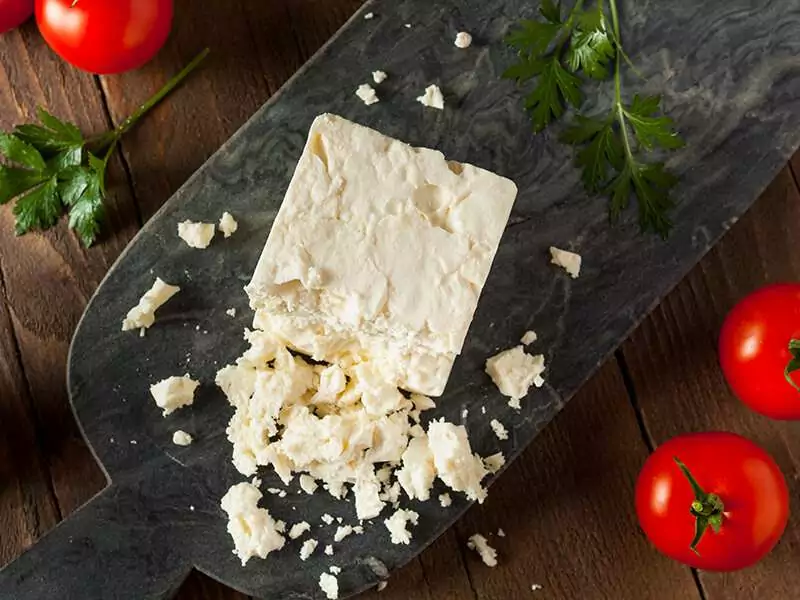
So, How Can You Describe Feta Cheese Flavor?
You might have tried feta cheese before, but have you tried all versions of this cheese? I mean, different feta cheese varieties in various countries.
The true feta cheese is the Greek one, but there are many other versions, like French, Danish, American, Bulgarian feta, etc.
And as they can be made from different ingredients in distinct ways, feta’s flavors are varied. Some are creamy, some are salty, or some are flavorful.
However, for the most authentic feta – Greek feta, you will feel their tanginess, saltiness, briny flavor with a bit of lemony aftertaste. Overall, Greek fate’s taste is pretty sharp that makes them stand out.
So, please keep reading for more information about how feta cheese tastes varied and their other information.
Master Your Knowledge About Feta Cheese
Not everyone knows this cheese. So before you learn about feta cheese taste, it would be best to discover what feta cheese is and its basic information, like its origin, its other characteristics, how people use it in cooking recipes, etc.
Now, let’s start this post with the details of feta cheese’s origin.
The History Of Feta Cheese
Cheese has a very long history. People believe that cheese was invented in the Eastern Mediterranean areas 8,000 years ago.
The feta’s first ancestor was from Greece in Homer’s time. Cyclops Polyphemus – a son of Poseidon and Thoosa in Greek Mythology, was the one who found this cheese by accident.
He left his sheep milk in a container made from an animal stomach, and when he realized it, Cyclops Polyphemus found out his milk was curdled but still tasted good.
The term ‘feta’ emerged in the 17th century. This word literally means ‘slice’ in Italian, describing how people slice the cheese up and keep it in the barrels or slice them into thin slices before serving.
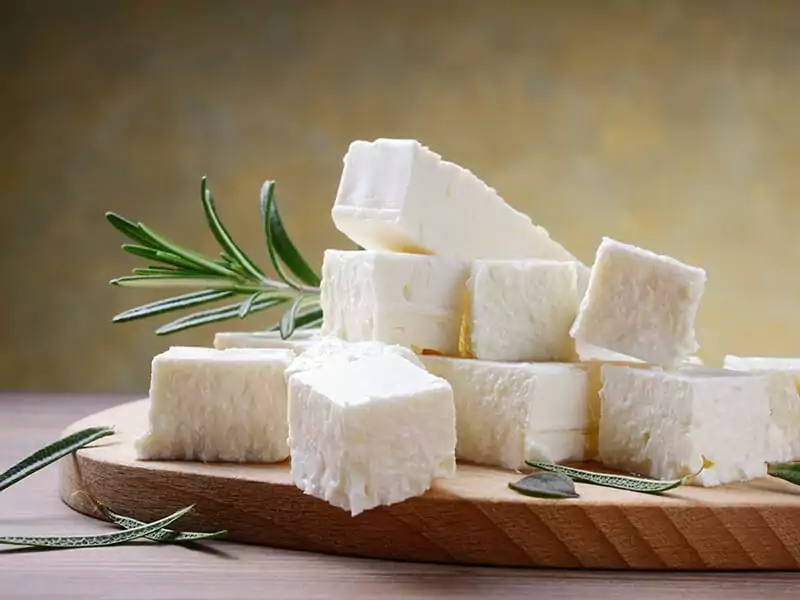
How Feta Cheese Is Made
Traditionally, feta cheese is made from sheep milk or sheep and goat milk. According to European Union legislation, feta cheese has to contain a minimum of 70% sheep milk and a maximum of 30% goat milk. And it must be produced in Greece and Lesbos Prefecture (1).
So if you find feta cheese made outside the EU or in the United States, it is not authentic feta cheese. And some of them might be made from cow milk.
To make feta cheese, traditionally, milk will undergo the pasteurization process, then the living cultures (as microorganisms) are added into the milk to increase the sour and other flavors.
The pasteurized milk has to cool down at 95 F degrees (around 35 C degrees), then people will add rennet and casein to make the milk curdle.
They also dry these milk curds before slicing them into smaller blocks and salting them. Once the saltiness reaches 3%, they will store them in wooden (or mental) barrels to infuse in some days.
When the cheese is ready to sell, people will cut them up and keep them with their brine in a plastic food container as feta cheese is easier to dry out.
However, it is possible to create homemade feta cheese. It will take a lot of time to make, but the process is pretty straightforward. Here are 10 steps to make feta cheese at home.
Step 1: Pour milk into a large pot and heat them slowly at 86 F degrees.
Step 2: Add the culture and let it rehydrate in 5 minutes, then give your milk a good stir to mix them all. After that, let the milk mixture stay at 86 F degrees for 1 more hour in a closed pot.
Step 3: Add calcium chloride, rennet, and stir again in 1 minute. Close the lid and let it sit for another 1 hour.
Step 4: After this time, the milk starts to form curd. Use your finger or a knife tip to check for the clean break.
Step 5: Use a curd cutting and a knife to cut the milk curd into smaller pieces, close the lid again and wait for 5 more minutes.
Step 6: Use a spoon to lift the curd gently in around 20 minutes.
Step 7: Drain the milk curd with a clean cloth in 30 minutes.
Step 8: Now, you can spoon the curd into a smaller basket covered by a clean cloth as well. Close the top of your basket by folding the cloth. Then use another basket to press the milk curd and squeeze out the excess water.
Step 9: Use anything that weighs around 4.5 pounds to press the curd, then leave it there for 2 hours. Repeat the same technique for another side of cheese.
Step 10: After a total of 4 hours of pressing, now you can put your cheese into a brine. The pH of the brine should be from 4.8 to 5.2. Store your cheese in brine at room temperature within 3 to 4 days before consuming.
If you want to make feta cheese at home, this detailed guide is what you need.
Feta Cheese Taste Based On Their Types
You just know what makes feta cheese and its common types; now, I will move to the most critical topic of this article. This is about the taste of feta cheese.
However, there are various feta cheese types from different countries; they all have other flavor profiles. Some are tangy; some are salty. So check this table to see what they are and how they taste.
Greek Feta
This most authentic type of this cheese is made from sheep milk (mostly) or sheep and goat milk. It has a tangy, salty, briny, and sharp flavor. You might also sense a light lemony aftertaste after 1 bite of Greek feta.
They have a fine, rich, and creamy texture that you can easily crumble, making them ideal for adding to your salad, sausage, soups, etc. In fact, Greek feta made with goat milk is crumblier than the sheep type.
Let’s see how a chef shares her thoughts about the taste of Greek feta.
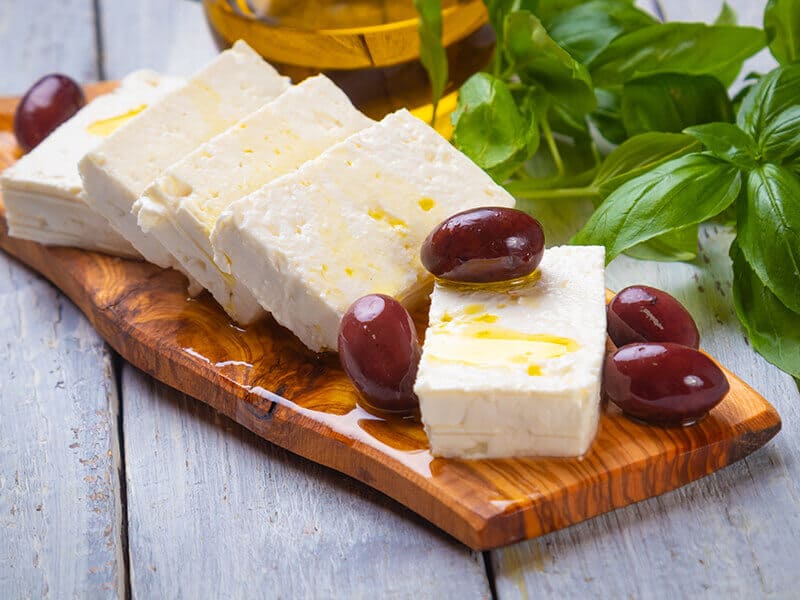
Bulgarian Feta
Bulgarian feta cheese can be made from sheep, goat, cow milk, or a combination of these kinds of milk. Because of the difference in milk, this cheese’s flavor is varied, but compared to other feta varieties, this one is saltiest.
They are also tangier than Greek feta but have a similar lemony taste as Greek ones. With a firm and creamy texture, you can slice them up and serve your cheese along with seasonings or olive oil.
French Feta
If you have a chance to travel to Southwest France, try to see how they make feta cheese there. This cheese is made from 100% sheep milk with a milder and less salty flavor than Greek and Bulgarian feta.
They also have a creamier and softer texture to combine perfectly with your roasted veggies or spread this cheese on bread.
Danish Feta
Danish-originated feta is made from cow milk. Their flavor is mild but will make your salad or grilled dishes tastier. By ultrafiltration process, this feta is creamier, smoother, and crumbly in texture.
Australian feta
This feta is often made from cow milk and marinated with herbs and seasonings. Their taste and texture are varied, but overall, Australian feta’s flavor is the balance of Greek feta’s saltiness and Danish feta’s creaminess.
They are primarily sold in packs with olive oil, making them more gooey and creamy. Served them with bread for the most enjoyed meal.
Israeli Feta
Like the authentic version, this cheese is mostly made from sheep’s milk and stored in brine for 1 month before being sold. Israeli feta has pungent flavors but is not too salty. And compared to Greek feta, this type’s taste is milder and less tangy.
Moreover, they have a creamy and moist texture, making them more suitable to slice rather than crumble.
American Feta
The most popular milk that people use to make this feta is cow milk. But you can also find sheep and goat versions. American feta is tangy but milder with a less creamy, drier, and crumblier texture.
Popular Culinary Uses Of This Amazing Cheese And Their Cooking Recipes
There are tons of ways that you can eat feta cheese, and here are some common examples:
- Enjoy cheese with veggie or plant-based dishes like salad or fruit
- Use them as pizza’s, pasta’s, or bruschetta’s topping
- Spread feta cheese on bread
- Ideal for sandwiches, even the grilled ones
- Cook them with meaty ingredients
- Baked cheese with peppers can be a good starter
- To make desserts like muffins, tarts, etc.
- Smashed feta cheese to make dips
And if you are still wondering what masterpiece you can make with feta cheese, below are 4 iconic yet tasty dishes for you to try.
Greek Feta Dip
Let’s start with the super easy recipe with dip. This is a Greek feta dip that you can serve along with chips or bread slices.
With less than 5 minutes to prep and mix all ingredients, your dip now is full of contrasting textures with soft, smooth, crumbled feta cheese, crunchy tomatoes, and cucumber. So if you are too lazy to cook anything this weekend, give this dish a try.
Minimal prep and few ingredients to make flavorful feta dip are perfect for enjoying your day.
Baked Feta Cheese With Olives and Tomatoes
If you want to add a quick and simple appetizer, this idea is for you. Baked feta cheese with olives and tomatoes will bring so many levels of deliciousness and stimulate your hunger before getting to the main meal.
Feta cheese, olives, and tomatoes are the main ingredients combined with seasonings and herbs to create a hit-maker dish to start the party. So, hurry up! Pin this recipe to your phone now.
Greek Cucumber Salad
This no-cooking recipe is another example to prove how feta cheese can work well with various veggies. And I guarantee this salad’s vibrant color will enchant you from a first look.
First, you will prepare a dressing in a big bowl by combining vinegar, oregano, mustard, and flavorings. Then add other veggies and cheese and give this mixture a good stir. And that is it. That is how you create a piece of art in the salad world.
Spinach and Feta Cheese Tortellini
Spinach might not be your favorite vegetable. But if you mix it with cheese and tortellini, you might change your mind.
Indeed, this pasta dish is so flavorful, tasty, and easy that it deserves a medal. You do not even need an hour in the kitchen, as this recipe is pretty straightforward. Remember to set the low heat to avoid overcooked spinach and tomatoes.
Just only in 20 minutes, a warm and hearty pasta with feta cheese is ready to serve.
What You Should Know In Choosing And Storing Feta Cheese
If you think buying cheese is just going to the store and picking one, you will think again after reading this part.
And the way you store them also affects their shelf life. Therefore, I will teach you how to keep them last longer at home. And what you want to know is shown in the 2 below sections.
Top 5 Expertise Tips To Buy The Best Feta Cheese
There is so much more that you should know in buying feta cheese, as this cheese has some distinctive characteristics you must consider before making a purchasing decision. And here are 5 straightforward tips for it.
Tip 1: Check For Production Origin
Yes. It should be from Greece. True feta is acknowledged by Protected Designations of Origin (PDO) by the European Commission to qualify that this cheese is made in Greece and by traditional technique.
You can find numerous feta cheese at the supermarket, but it might just be on the label. Some of them do not originate from Greece, especially when you do not live in Europe.
Tip 2: Check For Ingredients
Authentic feta cheese’s components are only sheep’s milk (or goat’s milk), salt, and rennet. So if you see the ingredient of the feta cheese is cow’s milk, this one is not authentic Greek feta. It is just feta-like cheese that is made in the USA.
In fact, cow’s milk feta has a drier texture, so they are easier to crumb. Though their flavor is mild, it tends to be sour, and the aftertaste is not too good. Also, you can feel this feta version is pretty mushy with an unpleasant smell.
Tip 3: Choose Block Cheese In Brine Instead Of Crumbled Ones
I know crumbled cheese might be easier for you to add to many dishes, but these cheeses also have powdered cellulose and anti-caking agents in their ingredients. Moreover, the shelf life of crumbled feta cheese is shorter than brined block ones.
This guidance will help you understand why you should not pay for any pre-crumbled feta cheese.
Tip 4: Check For Cheese Color and Texture
Good feta must have white color, not yellow. If the brined block cheese is yellow, it implies that the cheese is mishandled or exposed to the air. And the cheese should have many small holes on its surface.
Tip 5: Choose Plain-flavor Cheese
You might find there are various marinated feta or feta with dried herbs. But if you want to taste the exact flavor of feta, you should choose the plain ones. Plus, the herbs in your cheese might shorten the shelf life of the cheese as well.
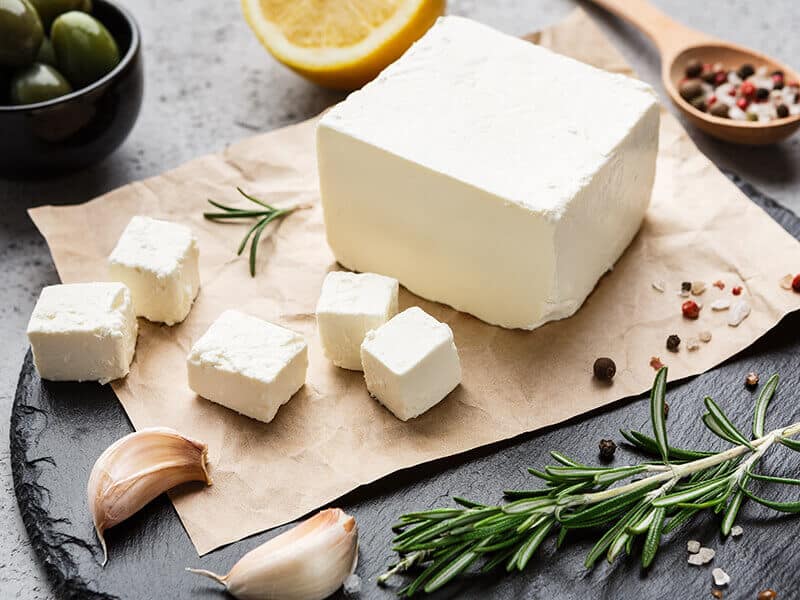
Best Method To Store Feta Cheese At Home
Every food has a specific shelf life, and feta cheese is not the exception. So understanding how to treat your cheese is essential, especially about how you are gonna store it. Proper storage results in longer using time.
Besides proper care, their shelf life is also affected by how they are processed or packed. You can check the best-by date on the label. But in reality, you can still consume your cheese after the best-by date a few more days, but the taste and texture are not good anymore.
To keep your cheese fresh, you should not keep them at room temperature. Instead, the best way to store it is in the fridge. Avoid freezing cheese, as when you thaw your food, this texture will be ruined.
As mentioned above, crumbled cheese cannot last long like feta cheese in block form, especially those sold in brine.
You can only keep the unopened crumbled cheese in the fridge up to 7 days after the sell-by date. For block cheese with brine, you can store the unopened one for up to 4 weeks after the sell-by date.
Once you open your feta package, if they are not in brine, their ideal shelf life in the fridge is only up to 1 week. But those that come with brine will last longer, up to 4 weeks.
| Types | In The Fridge |
| Unopened feta crumbled cheese | Sell-by date + 7 days |
| Unopened feta cheese block (with brine) | Sell-by date + up to 4 weeks |
| Opened feta cheese (without brine) | Up to 7 days |
| Opened feta cheese (with brine) | Up to 4 weeks |
Not-optimal yet still-work method is keeping your feta in the freezer. It could last about 6 months for an unopened package with brine and about 2 months for an opened cheese with brine.
In case you buy a block of feta cheese without brine, you can make this brining solution at home as this brine recipe is simple.
All you have to do is combine 1/4 cup of salt with 3 cups of cold water. Then you have to transfer your cheese to a bigger container, where it can keep both cheese and brine. Make sure the solution covers the whole cheese block. Close the lid tightly and store them in the fridge.
There are also 2 other ways to store feta in liquid. You can keep your blocks of feta cheese well in olive oil or milk. Just be noted that the liquid must cover the cheese.
There are 3 brilliant and easy ways to preserve feta cheese with liquid.
Health Benefits From Consuming Feta Cheese That You Might Miss
Feta cheese is low in calories and fat. They are also one of the healthy cheeses packed with vitamins and minerals. There are 4 potential health benefits of feta cheese:
- Good For Your Bone: The calcium in feta is higher than in other cheese, making them become an excellent source to improve your bones and teeth. Also, the combo of phosphorus and calcium in feta is perfect for preventing osteoporosis.
- Good For Your Digestion: As a fermented dairy food, fete cheese is famous for its probiotic properties. It will help your gut work better and improve your immune system as well.
- Feta Cheese Contains Good Fatty Acid: This acid is called Conjugated linoleic acid (CLA) and can be seen as an anti-cancer fighter. By consuming feta cheese, you can lower the risk of cancer.
And it has been proven by the research that Greece people have the lowest rate of breast cancer with the highest level of feta cheese consumption (2). Plus, thanks to this acid, you can get fit and reduce body fat.
- Can Prevent Diabetes: High calcium and protein in feta cheese can regulate your blood sugar well, lowering the risk of diabetes.
FAQs
Is there anything else about feta cheese that comes to your mind? If yes, these 5 below commonly asked questions and answers might help you discover more about this special cheese. Check it out!
What Do You Think About Feta Cheese Taste (Or Smell)?
If you are a true fan of feta cheese, I believe this article can help you complete the knowledge about this fantastic cheese. Indeed, feta cheese is so versatile in cooking so that you can create any delicious meal at home for your beloved family.
Lastly, do you love this cheese as much as I do? Please share your experience with the taste of this cheese in the comment section. I’d love to hear your response. Thank you for your time.
References
- En.wikipedia.org.. Feta – Wikipedia. [Online]. Available at: https://en.wikipedia.org/wiki/Feta.
- Spiros Zlatanos et al. 2002, ‘CLA content and fatty acid composition of Greek Feta and hard cheeses’, Food Chemistry, vol.78 (4), pp. 471-477. Available at: https://www.sciencedirect.com/science/article/abs/pii/S0308814602001590.




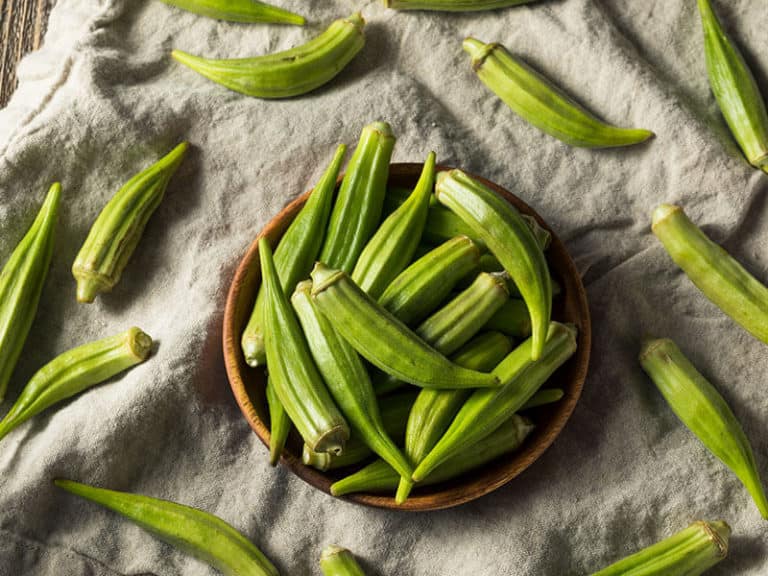
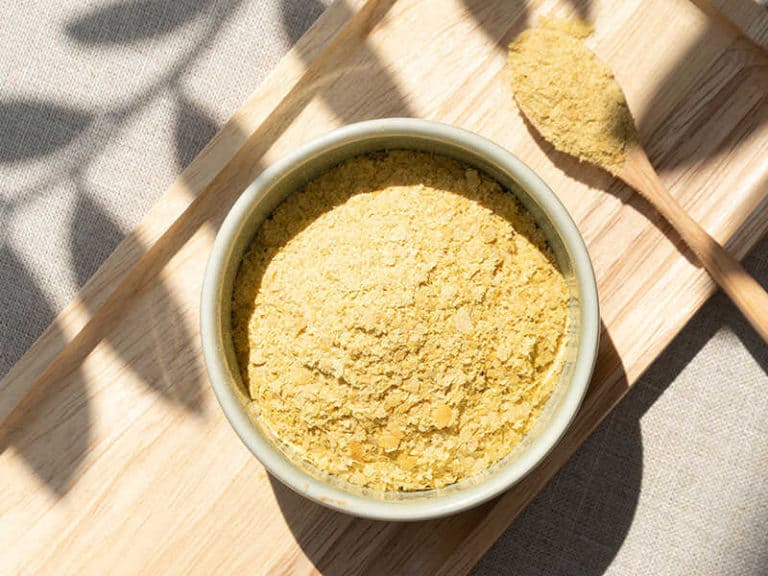

Amanda Collins
Founder and Senior Culinary Editor
Expertise
Culinary Arts and Management, Food Journalism and Critique, Recipe Development and Testing, Global Culinary Traditions, Sustainable Food Practices
Education
Institute of Culinary Education (ICE), New York, NY
Program: Diploma in Culinary Arts
Focus: Intensive hands-on training in culinary techniques, recipe development, and kitchen management, preparing students for professional roles in the culinary industry.
Monroe College, New Rochelle, NY
Program: Associate in Applied Science in Culinary Arts
Focus: Practical culinary skills, including cooking techniques, menu planning, and kitchen operations, with an emphasis on hands-on experience and industry standards.
Amanda Collins is a seasoned chef and food editor with a deep love for global flavors. Trained at the Institute of Culinary Education and Monroe College, and with over 15 years in the culinary field, Amanda has refined her skills in kitchens worldwide. Her background in food studies gives her a unique ability to share both recipes and the cultural stories that shape them.
As senior culinary editor at thebreslin.com, Amanda’s work brings authentic dishes to life, inviting readers to explore new flavors and techniques from around the globe. Her approachable style makes it easy for anyone to bring a bit of the world’s cuisine into their kitchen.